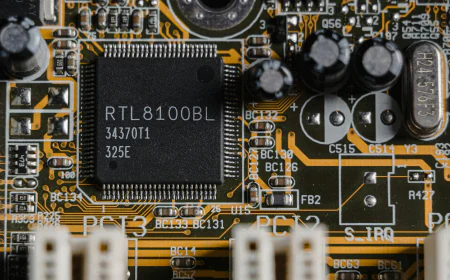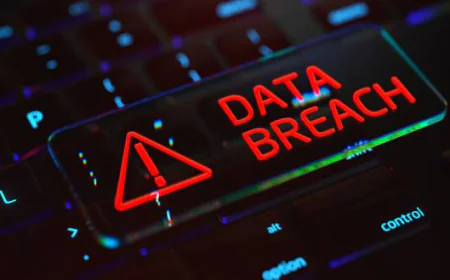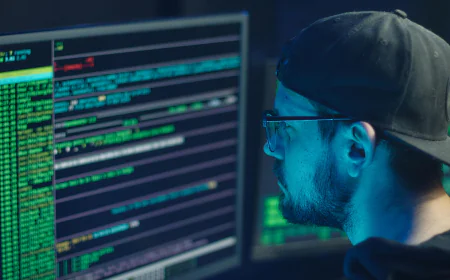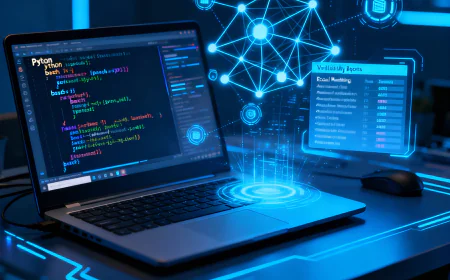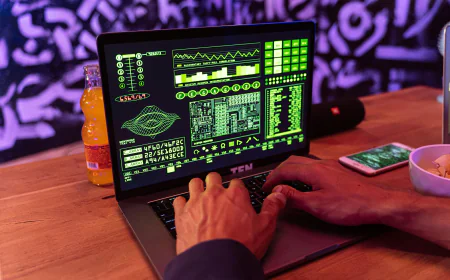Cyber Attacks Surge in 2024: How Organizations Can Survive the New Digital Onslaught
Cyber attacks surged 30% in 2024, targeting industries like healthcare, finance, and infrastructure. AI-enhanced threats and human errors drive risks. Multi-layered defenses and training are crucial for resilience.

In our digital world, the threat of cyber attacks is a security challenge all individuals, businesses, and governments face across the globe. A cyber attack is described as an intentional, malicious act by an individual or organization to penetrate or access an information system to disturb, damage, steal, alter, or gain unauthorized access to the system of a device or computer networks.
By 2024, the intensity of cyber attacks has reached remarkable proportions as organizations can expect to face an average of 1,636 attacks per organization weekly, a 30% increase of the number of attacks worldwide. The movement is warranted by rising scale and complexity of attacks, better defenses are [now] needed to combat all types of attacks.
The Analysis of a Cyber Attack
Cyber attacks can be from either outside or inside of an organization, and each internal and external attack presents its own specific problems and serious threats. An internal cyber attack is the one which originates from within an organization's security perimeter, like people who have authorized access to sensitive information and decide to misuse their access for malicious reasons. An external cyber attack is the one which occurs from outside of the organization's security parameters, which includes distributed denial-of-service (DDoS) attacks with botnets (like a cyberattack that floods a target server, service, or network with a massive amount of malicious internet traffic, rendering it unavailable to legitimate users), which are up 46% in the first half of 2024.
Cyber attacks can be classified as either active or passive; the key difference will revolve around approach and impact to the targeted systems. Active cyber attacks focus on deliberate attempts to change how systems work or disrupt operations. Ransomware attacks and data breaches are both examples of active attacks. Passive cyber attacks focus on attempts to gain access to information while being unconcerned with if the target's systems are affected. Furthermore, passive cyber attacks could often occur when virtual reconnaissance is performed to prepare for an aggressive cyber attack.
The Most Dangerous Cyber Attack Vectors
Ransomware: The Billion-Dollar Threat
In the year 2024, ransomware attacks have emerged as one of the most financially destructive styles of cyber attacks. Ransomware are malicious software programs that encrypt a victim's files and demand payment to provide the decryption keys. The threat posed by ransomware has evolved drastically, with 59% of all cyberattacks on organizations in 2024 classified as ransomware attacks, with as many as 20 to 25 major ransomware attacks reported daily.
The financial consequences of ransomware attacks are remarkable. The total payments made to ransomware attackers were approximately $813.55 million in 2024, compared to the all-time high of $1.25 billion in 2023. Again, the reduction is not attributed to fewer ransomware attacks, but rather lower payments, as the 2024 Q4 data said only 25% of victims paid a ransom. 2024 also included high-profile ransomware incidents that impacted surrounding communities.
For example, the Change Healthcare incident involved approximately $2.87 billion in response costs for UnitedHealth Group and more than $6 billion in claims reimbursements for affected healthcare providers. The Change Healthcare ransomware event disrupted healthcare services for people across the country as patients had to pay out of pocket for medications and services.

Phishing: The Gateway to Compromise
Phishing remains the top attack vector for cyber attacks, with 84 per cent of businesses and 83 percent of charities reporting being victims of phishing attacks. The sophistication of phishing attacks is increasing; in fact, phishing attacks are up by 1235 percent primarily driven by the rise of Gen AI.
While advanced technology has raised the sophistication of cyber attacks to never-before-seen levels, the reality is that phishing attacks are, and will remain, effective because they are predicated on threatening human beings. Attackers send messages making them appear to be from trusted sources to trick the victim into provide their login credentials, credit card information, and even access to how the organization functions. In many instances, phishing attacks are a precursor to larger cyber attacks that are even more harmful. A whopping 40 percent of all email-related threats are phishing attacks.
Advanced Persistent Threats
Advanced Persistent Threats (APTs) are complex cyber attacks typically connected with nation-state actors. APTs are highly complex, stealthy, and long-term in nature, and are carried out in several stages:
Initial Reconnaissance to identify vulnerabilities
Infiltration using spear-phishing and/or a zero-day attack
Lateral Movement within other systems on the target network
Exfiltration of data or manipulating the system over a sustained period of time
Artificial Intelligence-Powered Cyber Attacks
The utilization of artificial intelligence in cyber attacks marks a clear evolution in threat sophistication. Studies indicate that 80% of ransomware attacks involve the use of artificial intelligence, allowing attackers to: Perform AI powered reconnaissance that allows analysis of a network’s configurations and detection of optimal targets Use machine learning algorithm enabled malware to evade detection by mimicking natural system operation Conduct automated exploitation of systems that rapidly and systematically search a network for vulnerabilities and adapt attack strategies in real time Leverage intelligent targeting through applications of natural language processing to locate the most valuable data to encrypt The concern here is the speed and scale that AI provides to an attacker. What took days or weeks by a human attacker can occur in minutes or seconds, and as AI allows targeting millions of systems simultaneously, the attacker can scale their operation to levels never before possible.

Industry-Specific Cyber Attack Trends
Healthcare Under Siege
The healthcare sector has always been an appealing target for malicious hackers, whose actions lead to serious problems in patients' care and safety. The financial burden on healthcare organizations is exceptionally large: in 2023, a data breach in the healthcare sector was on average $10.93 million per case which was the highest among all sectors of the economy.
2024 witnessed the hacking of major healthcare organizations which caused severe security bugs. These included: the ransomware incident at Ascension Health System that put the operations of several hospitals at a standstill; the MediSecure hacking where hackers accessed the data of millions of patients; the ransomware incident at Synnovis-NHS UK which led to the interruption of blood testing.
Financial Services Vulnerabilities
Hackers are always targeting the financial sector, and a recent survey done in 2024 showed that 65% of banks and other financial institutions worldwide experienced a ransomware attack. The interconnectedness of the financial networks means that the success of a single cyber operation, to such an extent, can bring the entire economic system to a standstill.
Critical Infrastructure Targets
Cyber attacks by nation-states are becoming more frequent and aimed at critical infrastructures like energy systems comprising electric grids and natural gas lines, transportation systems, and telecommunication, water treatment plants, etc. The attack on Colonial Pipeline done by the Russian hackers DarkSide is a perfect illustration of the point that attacks on critical infrastructure can, in turn, cause around the world economic and social impacts.
The Human Factor in Cyber Attacks
Technological progress has not eliminated the human factor which is still responsible for 68% of breaches, while human error accounts for 90% of cyber attacks. This figure highlights the indispensable necessity of including human factors in the cyber attack prevention strategies, especially the addressing of their vulnerabilities.
Cyber attack vectors that are employee-related consist of opening malicious links in phishing emails, downloading infected files from unknown sources, using weak passwords or reusing passwords across several systems, and being tricked by social engineers. Investing in thorough cybersecurity training brings measurable enhancements to the security posture of the organizations, but still, 44% of companies attribute lack of personnel or capacity as a potential cause of their cyber attack vulnerabilities.

Economic Impact of Cyber Attacks
The monetary repercussions of cyberattacks expand far beyond the immediate costs connected to incident response. The financial burden of cyber incidents has increased four times in the period since 2017, and in the case of a major attack, the loss could reach up to $2.5 billion just for the worst scenario.
Ransom payments and negotiation costs, system restoration and data recovery costs, legal fees and regulatory compliance expenses, and forensic investigation costs account for the primary expenses incurred by cyberattacks. The losses derived from the interruptions in the business and the reputational damage caused to the company and the trust of its customers are the main components of indirect costs, which usually are significantly higher than the direct ones. Indirect costs also include regulatory fines and penalties and the competitive disadvantage brought about by intellectual property theft.
Building Resilient Defenses Against Cyber Attacks
Multi-Layered Security Architecture
Preventing cyber attacks effectively necessitates a holistic, multi-layered technique that concurrently confronts different threat vectors. This approach ought to encompass various network security practices like deploying firewalls to eradicate harmful traffic, installing intrusion detection systems (IDS) for continuous monitoring, implementing network segmentation to hinder sideways movement of attackers, and using virtual private networks (VPN) for encrypted access to remote workstations.
Equally important is endpoint protection that mixes next-gen antivirus supply with behavioral learning, Endpoint Detection and Response (EDR) systems, device encryption for safeguarding data at rest, and mobile device management in BYOD contexts.
Advanced Threat Detection and Response
Sophisticated detection and response abilities are necessary for modern cyber attack defense. AI assisted security consists of machine learning algorithms for anomaly detection, behavioral analytics of suspect activities, automated threat response for rapid containment, and predictive threat intelligence for proactive defense.
Security Information and Event Management (SIEM) systems offer centralized log management for full visibility, real-time correlation of security events, automated alerting for critical incidents, and forensic capabilities for post-incident analysis.
Employee Training and Awareness
Human errors have a large share of 90% in causing cyber attacks, so very comprehensive and effective employee training is a must. Employee awareness through phishing simulation exercises, security awareness workshops aimed at staff about the latest threats, incident reporting procedures for any suspicious activities, and updates on the tactics of cyber attackers should all be included among the training components.
Emerging Trends in Cyber Attacks
Cloud Security Vulnerabilities
The widespread adoption of cloud services among organizations has led to a significant rise in cloud intrusions, which went up by 75% in 2023. In addition, cloud misconfigurations accounted for 23% of the security incidents in the cloud. Cyber attacks directed towards the cloud infrastructure have taken advantage of the misconfigured storage being the major factor in exposing the sensitive data, weakly managed esp. identity and the access controls, lack of proper network security measures in cloud environments and third-party service vulnerabilities in supply chains.
Internet of Things (IoT) Exploitation
The growing number of connected devices has opened up new surfaces for cybercriminals to attack. Approximately 107% more IoT malware attacks were recorded in 2024 with the attackers going after smart home devices using default passwords, industrial IoT systems managing crucial processes, and medical devices in the healthcare sector, and also connected vehicles and transportations.
Best Practices for Cyber Attack Prevention
Organizational Security Policies
The first step in preventing cyber attacks effectively is the comprehensive security policies that combine the principle of least privilege, multi-factor authentication for all critical systems, regular access reviews and privilege audits, and zero-trust architecture adoption, thereby ensuring the utmost security of the organization’s IT infrastructure.
Security measures for data protection should allow for data classification and handling procedures, encryption of data in transit and at rest, secure disposal of sensitive information, and privacy by design in system development.
Technology Implementation
Preventing cyber attacks necessitates employing suitable security technologies such as web application firewalls for online services, email security gateways for phishing protection, DNS filtering to prevent access to malicious domains, and vulnerability management programs.
Detective controls should be inclusive of security monitoring and logging systems, threat hunting programs for proactive detection, digital forensics capabilities for incident investigation, and continuous security assessment tools.

Conclusion: Building Cyber Resilience in an Evolving Threat Landscape
The cyber attack scenario is becoming more and more sophisticated, and it is technological development, geopolitical tensions, and criminals' creativity that keep driving the large-scale cyber attacks. The number of global cyber-attacks has gone up dramatically, by 30%, and organizations are already overwhelmed with more than 1,600 attacks each week—in short, the situation is the most serious and the widest spread.
The complexity of cyber attacks today requires companies to change their security approaches completely and move from being reactive to implementing proactively and based on intelligence-driven defense strategies. Even though organizations would like to think that these attacks are only technical issues, the reality is that they are business-critical risks that need to be handled with the utmost seriousness, from the board-level and through the whole organizational structure.
The main reason for succeeding in confronting cyber attacks lies in adopting a unified technique that encompasses modern technology, thorough employee education, exceptional incident response planning, and constant improvement using threat intelligence. Such companies that are proactive in developing these technologies not only secure themselves but also play their part in the broader endeavor of establishing a more secure digital world.
When we start seeing the trends of 2025 and beyond, the succeeding companies will be those seeing cyber attack prevention as a cost center but rather as a strategic enabler of digital transformation and business growth. In times where cyber attacks can drain hundreds of millions of dollars from companies and even put critical infrastructure at risk, the companies that are well-prepared with cybersecurity measures will have the majority of the market—these are the companies that will not only survive but will also thrive in the digital age.

